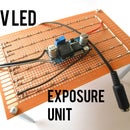Introduction: Electromagnetic Field (EMF) Detector With LM358
In this instructable I will show you how to make an Electromagnetic Field (EMF) detector with dual operational amplifier and 2 inductors.
With this device you can hear for example your TV or phone working.
The circuit is relatively simple. For me the hardest part was drilling the enclosure.
Step 1: Parts List
For this instructable you will need:
1x - EMF detector PCB (or you can use perfboard)
1x - 9V battery clip (6f22)
1x - stereo audio jack 3.5 mm
1x - LM358 - or any other pin compatibile dual opamp (TL072 works fine)
2x - 100mH radial inductor (may be labeled as 104J)
1x - LED (whatever color/parameters)
1x - potentiometer 500kΩ stereo linear
1x - 1N4148 or any other general purpose diode
3x - 1kΩ resistor
2x - 10kΩ resistor
2x - 100kΩ resistor
2x - 100µF electrolytic capacitor (any voltage rating)
4x - 2.2µF electrolytic capacitor (any voltage rating)
A few meters of hookup wire for wiring the potentiometer, audio jack etc. - I used 24AWG red and blue
Optional:
1x - enclosure (optional)
2x - LED holder 10mm
1x - LED holder 3mm
1x - SPDT switch
1x - 8 pin socket
Step 2: Schematic and Board
HOW IT WORKS
I powered this circuit from 9V battery although according to datasheet of lm358 you could use a voltage source as high as 32 Volts but then you would have to use capacitors with adequate voltage ratings.
The dual powersupply is achieved with a simple voltage divider.
A changing magnetic filed will induce current in the 2 inductors wich will then be amplified for the headphones by LM358.
To make the schematic and the PCB I used a free program CadSoft Eagle which I would recommend to anyone making schematics or PCBs.
Step 3: Etching the PCB
I did not make the video.
I etched the PCB with i guess "photographic method" - that would be the direct translation from my language. I printed out the PDF file from previous step on transparent foil and then shone through it on photosensitve PCB, then developed it in solution of sodium hydroxide and then etched it in ferric chloride. If you find it confusing just watch the video, It's very well explained.
Also don't forget to orient the transparent foil on the PCB so that you can read the words written on it.
Step 4: Soldering, Wiring and Testing the Circuit
At first I soldered all the flat components and then the higher ones. Then I used hookup wire to attach the potentiometer, inductors, switch, led and audio jack.
If you followed the instructions carefully the circuit should work on the first try. The best way to test it is to bring it near a working wall adapter but be careful with the volume! This circuit is very sensitive.
Step 5: Drilling the Enclosure and Fitting It In
For me the drilling is always the fun part because I often don't have the proper drill bits but when I have them I can not put them into my small hand dril anyway so I drilled most of the holes by turning the drillbits with pliers. Unfortunately I did not take any photos during drilling.
When you're finished drilling you can just screw everything in and enjoy your awesome EMF detector!
Step 6: Conclusion
For me this was a fun project and a good practice in PCB design and soldering.
If you manage to build this project don't forget to post your results into the comments.






